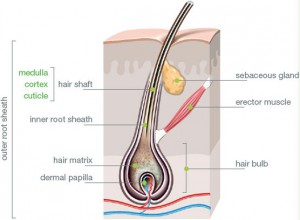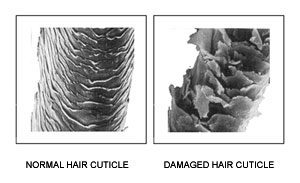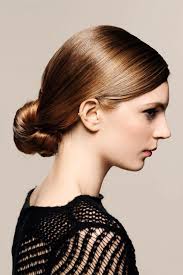
Naturally shiny hair
Hair Nutrition
It’s easy to forget that hair is a living part of our body and also easy to believe that to improve the quality of our hair we only need to use expensive salon quality shampoos, conditioners. While high quality hair products can certainly improve the shine and look of your hair they can never effectively nourish the hair at its root and establish vibrant new hair growth.
This is not an article about which shampoo you should use or which conditioning treatment works best its about using supplements how they can have a beneficial effect on your hair and scalp?
The Structure of Hair
Hair is actually made up of a number of different components.
The hair follicle is a small pocket just below the skin surface surrounded by nerves and when the hair is healthy there is a supply of rich nutrient-filled blood. Within the follicle is a hair bulb and the papilla, which supplies the growing hair with nutrients.

The structure of a hair
This tiny hair growing factory also contains a small muscle which responds to cold or fright and gives us those familiar goose bumps. In addition, the follicle contains an oil producing gland called the sebaceous gland. This gland produces a fine, natural oil which coats the growing hair and protects it from loss of moisture.
The hair shaft is what we see and its exposed as it leaves the surface of the scalp. The shaft consists mainly of keratin, a hard protein similar to that of our nails.
Keratin is very strong and supple and has great resistance because of a high content of sulphurated amino acids.
The second part of the hair shaft is the cuticle, a horny, scaly, outer layer that protects the inner protein fibers. It consists of overlapping scales like those of a fish. When the scales lie flat the hair is reflective and shiny and protected from damage as well as free of tangles.
The cuticle also protects the inner hair partially because it acts as a trap for sebum, the natural oil produced by the sebaceous gland.
If the cuticle becomes damaged and breaks away, the inner fibers will fray leading to breakage and split ends.
Underneath the cuticle is the next layer called the cortex. It is made up of millions of keratin fibers twisted around each other like a rope. This cortex is responsible for the thickness and strength of the hair and contains pigment that determines your natural hair color.
In the very center of each hair is a canal made of soft keratin called the medulla. Its function is unknown. Sometimes the medulla is missing altogether, and it’s believed that poor health and unbalanced nutritional intake is responsible for its disappearance.
In fact, when the body is undernourished, it shuttles nutrients to the most critical lifesaving organs and glands.
Anything “non-essential” – including hair – is basically starved of nutrition.

Shine and gloss hair
And in reality, that makes perfect sense. Our hair has very little to do with improving the quality of our health, and that’s why it is sacrificed by the body to protect more critical functions.
To really nourish and sustain healthy hair growth a diet which contains high levels of the following active ingredients are important.
A side effect of these simple diet choices is the possibility of better health!
Sulphurated amino acids.
Two of the sulphurated amino acids for new hair growth are L-methionine and L-cysteine. These are the basic building blocks of hair, they are essential for the formation of keratin and promote hair growth.
Your body can and does produce some cysteine on its own from another amino acid – methionine, which is also a sulfur-containing amino acid. Methionine is an essential amino acid, meaning it is not produced by the body but comes from diet only.
Food sources of methionine are: all meats and poultry, fish, eggs, dairy, quinoa, buckwheat, sesame seeds, Brazil nuts, and to a lesser degree dry spirulina. While methionine can be found in other foods as well, such as beans and legumes, the amount of methionine is too low to be of any benefit for significant cysteine production and ultimately glutathione production for your immune health. Small amounts of cysteine can be found in other plant sources: broccoli, Brussels sprouts, red and yellow bell peppers, onions, garlic.
Cysteine is available as a supplement from health food stores and pharmacies. It is usually labeled “L-cysteine”, and the most common dosage is 500 mg in pill, tablet or capsule form.
Science has proven that supplemental cysteine may in fact raise intracellular glutathione to a small degree, especially in cases of severe glutathione depletion.
However, cysteine as a dietary supplement can promote hypercysteinemia and can be potentially toxic. Its absorption into bloodstream is limited because it is easily oxidized in the digestive tract. Further oxidation in the bloodstream leads to formation of potentially toxic byproducts, some of which may contain a highly reactive oxidant – hydroxyl radical.
Cysteine toxicity leads to a number of disorders in the body, from heart disease to renal (kidney) disease. Due to the potential for cysteine toxicity, excessive homocysteine levels and potential hypercysteinemia, it is not recommended to take L-cysteine supplements without strict supervision from your doctor, especially if there are underlying health conditions
B Vitamins.
B vitamins, necessary for virtually every function in the body, also contribute to healthy hair and skin. The B vitamins that need to be a part of a hair renewing formula include riboflavin, B6 (as Pyridoxine HCl), folic acid, pantothenic acid (B5), and biotin. While they all have a role, I’d like to focus on two of them: vitamin B6 and biotin.
Vitamin B6. This vitamin plays an important role in the absorption of the sulphurated amino acids, the building blocks of healthy hair that I mentioned before. Interestingly, there has been recent scientific research that shows that vitamin B6 and l-cysteine helps prevent alopecia (hair loss) induced by chemotherapy. While there is more work to be done on this front, I think the indications are very hopeful.
Biotin is another B-vitamin that is a must for healthy hair and skin. It is found in a number of food sources, including egg yolks, milk, barley, liver, royal jelly and brewer’s yeast. For the full benefits, a supplemental source is best. Biotin helps the body synthesize and use fatty acids and metabolize amino acids.
If you eat meat, fish or dairy foods, you should be able to get enough vitamin B12 from your diet. However, because vitamin B12 is not found naturally in foods such as fruit, vegetables and grains, vegans may not get enough of this vitamin.
It helps DNA replicate properly, so it an extremely necessary nutrient for a variety of reasons. Those born with metabolic disorders can be prone to severe biotin deficiencies, and suffer from alopecia as a result. However, anyone following the standard American diet of refined foods needs a strong source of the nutrient to help build the structure of keratin for strong hair and nails.
In fact, a Swiss study found that 63 percent of those using a biotin supplement showed a 25 percent increase in nail thickness when they previously had dry, brittle fingernails.
Biotin deficiency is serious.
If you have alopecia, dermatitis, or weak nails, you definitely need this B vitamin.
Millet Seed Oil Extract. Supercritical (CO2) millet (Panicum miliaceum) seed oil extract is processed with no harsh chemicals – only carbon dioxide.
Carbon Dioxide helps preserve the seed oil’s natural valuable compounds, including linoleic acid, miliacin, and other plant sterols that are crucial for sustaining hair growth.
While each component of millet seed oil extract is important, miliacin is the heavy hitter. It increases cell metabolism, and stimulates cell proliferation and tissue regeneration – exactly what you want for restoring healthy hair.
Miliacin is backed by clinical studies that show that it supports the formation of lustrous and healthy hair. It also activates the body’s own repair mechanisms to heal skin and reduce inflammation.
In a clinical study, cancer patients were divided into groups receiving millet seed soil extract and chemotherapy, or chemotherapy alone.The grade, or severity, of hair loss was assessed by World Health Organization (WHO criteria).
Those in the millet seed group saw significantly lower percentages of hair loss. The extract, given orally, was well tolerated in all patients – a challenge when chemotherapy is part of the treatment. Certainly, more work needs to be done to establish effectiveness and timing (how early before chemotherapy treatment to begin using the extract), but these results are still reason for hope.
Sunflower seed oil. This excellent oil provides valuable omega-6 fatty acids that are necessary for healthy hair. Sunflower seed oil also contains lecithin, phospholipids, tocopherols, carotenoids and has a very high content of vitamin E. It helps retain moisture in the skin and hair, and may provide a protective barrier as well.
Silica. A lack of silica can lead to skin, nail and hair disorders as well as growth problems. But how often do you get silica through dietary sources? Probably not very often.
The silica I recommend is an organic ingredient obtained from the above-ground parts of the common horsetail (Equisetum arvense) plant. In a special process, the silica in the plant is extracted while still attached to the plant bioflavonoids that support its activity in the body. At the same time, all the harsh and potentially harmful substances are screened out using this gentle process. This unique botanical silica is then blended with a specific marine oil to enhance absorption, beneficial effects, and cell membrane penetration of the active compounds. This form of silica is extremely soluble and virtually 100% bioavailable for the body.
While there are other supplemental sources that are either mined from rock or synthesized in a lab, they are not the same. To begin with, plant-derived silica has higher levels of bioactivity than all other forms. In fact, the stem of the common horsetail is about 80% silica!
A Formula for Great Hair
These nutrients are exactly what you need for strong, lustrous hair growth.
Plus, because it is hormone-free, it will not cause undesirable hair growth on other areas of the body. It is a safe and natural way to encourage healthy hair, regardless of gender or age. The other advice is to be patient!
Stick with these nutrients for at least three months. New hair growth may respond very slowly and while you may see results with greater beauty and thickness, allow ample time for new hair to grow in as well.
Scalp issues:
Conditions responsible for dry scalp and flakiness
There can be several conditions associated with dry scalp and flakiness. Dry scalp may arise from cold weather due to lack of humidity or due to eczema– a skin disease. Let’s list the conditions which lead to dry scalp.
Changes in weather-During winters, the humidity present in the air is low. This leads to the problem of skin dryness. This may lead to itching on scalp and small flakes.
Hot Showers– While there is nothing comforting than a hot bath/shower, taking hot showers too many times only aggravates scalp damage. The extreme temperature of hot water breaks down the lipids in skin, leading to dryness and flakes on hair.
Exposure to sun– Any kind of exposure to heat may lead to the problem of dry scalp. Lower the exposure with covering your head.
Coarse soaps and detergents- shampoos and detergents having anti-bacterial agents in them tend to shred lipid and dehydrate skin. Mild shampoos and herbal shampoos are helpful.
Central Heating– Continuous exposure to central heating or cooling tends to reduce the moisture in skin, and leads to irritation and itching. Avoid a big swing in your environmental temperature.
Seborrheic Dermatitis– Commonly known as Dandruff, this form of skin problem affects areas with more oil concentration.
Plaque Psoriasis– A common form of psoriasis occurring anywhere on skin, it produces white scales and reddish scales. Symptoms include dry skin, itchy scalp, bleeding and soreness.
Malassezia Folliculitis– A fungus living on scalp, this feeds on oil secreted by hair follicles and go out of control. It irritates skin, and grows more skin cells.
Dandruff /Scaling:
Supplementing your diet with good quality omega-3 in the form of krill oil or fish oil could help alleviate these troublesome and uncomfortable symptoms.
Dandruff, as well as other dry-skin conditions, can often be a sign that you have a fatty acid imbalance. This is a very common problem, as the standard American and Uk diet is far higher in omega-6 than omega-3. Your ideal ratio of omega-6 to omega-3 fats is 1:1. But the current ratio of omega-6 to omega-3 in the average American diet varies from 20:1 to 50:1! So increase your Omega 3 intake by using a good supplement.
In addition to that, keep in mind that everything you slather on your skin, and put on your scalp goes into your bloodstream, and can affect your overall health and internal balance. Virtually all of your regular shampoos and conditioners contain harmful chemicals that can create skin irritation, contributing to dry scalp and excessive dandruff.
I recommend buying organic personal-care products that do not contain parabens and sodium laureth, or lauryl sulfate. The latter two are known eye and skin irritants.Ask us when in our salon for advice on products you can purchase in our Salon that can help..
I think you’ll be happy with the results.

